Theology Essay: Key Theological Points in the Epistle to the Trallians
VerifiedAdded on 2021/04/21
|6
|1253
|396
Essay
AI Summary
This essay provides an in-depth analysis of the Epistle to the Trallians, a letter written by Ignatius, the Bishop of Antioch, in the early second century. The paper focuses on the theological points presented in the letter, including the significance of the phrase 'God Jesus Christ' and the emphasis on the resurrection of Jesus Christ. The essay explores Ignatius's views on the impact of false teachings, particularly Docetism, and his defense of the physical nature of Jesus Christ. It highlights the importance of sacrificing life for the Gospel and the early Christian beliefs against Judaizers. Furthermore, the essay examines the interesting aspects of the letter, such as its support for Presbyterianism and the role of deacons. The conclusion emphasizes the theological facts and Ignatius's messages to the human beings.
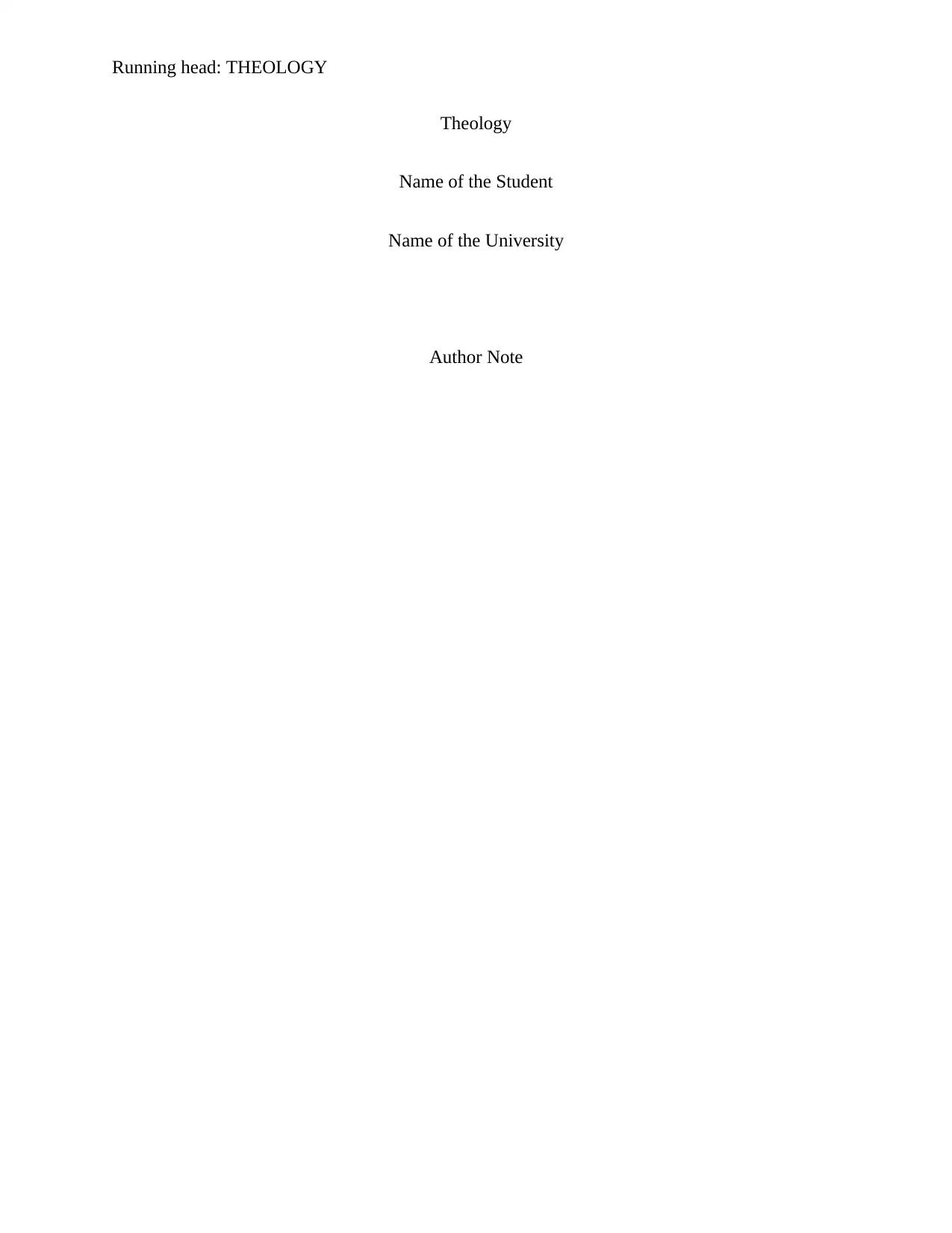
Running head: THEOLOGY
Theology
Name of the Student
Name of the University
Author Note
Theology
Name of the Student
Name of the University
Author Note
Paraphrase This Document
Need a fresh take? Get an instant paraphrase of this document with our AI Paraphraser
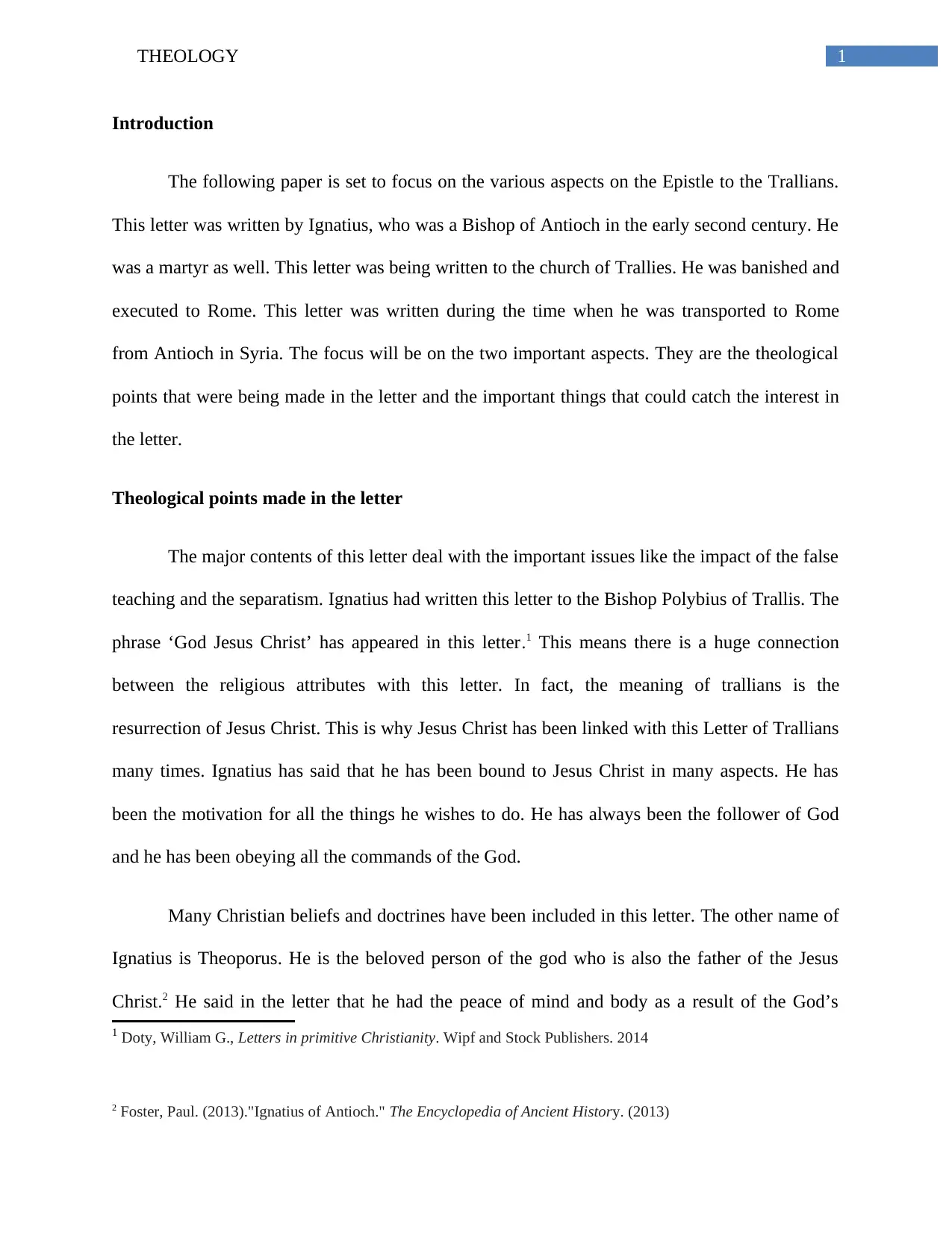
1THEOLOGY
Introduction
The following paper is set to focus on the various aspects on the Epistle to the Trallians.
This letter was written by Ignatius, who was a Bishop of Antioch in the early second century. He
was a martyr as well. This letter was being written to the church of Trallies. He was banished and
executed to Rome. This letter was written during the time when he was transported to Rome
from Antioch in Syria. The focus will be on the two important aspects. They are the theological
points that were being made in the letter and the important things that could catch the interest in
the letter.
Theological points made in the letter
The major contents of this letter deal with the important issues like the impact of the false
teaching and the separatism. Ignatius had written this letter to the Bishop Polybius of Trallis. The
phrase ‘God Jesus Christ’ has appeared in this letter.1 This means there is a huge connection
between the religious attributes with this letter. In fact, the meaning of trallians is the
resurrection of Jesus Christ. This is why Jesus Christ has been linked with this Letter of Trallians
many times. Ignatius has said that he has been bound to Jesus Christ in many aspects. He has
been the motivation for all the things he wishes to do. He has always been the follower of God
and he has been obeying all the commands of the God.
Many Christian beliefs and doctrines have been included in this letter. The other name of
Ignatius is Theoporus. He is the beloved person of the god who is also the father of the Jesus
Christ.2 He said in the letter that he had the peace of mind and body as a result of the God’s
1 Doty, William G., Letters in primitive Christianity. Wipf and Stock Publishers. 2014
2 Foster, Paul. (2013)."Ignatius of Antioch." The Encyclopedia of Ancient History. (2013)
Introduction
The following paper is set to focus on the various aspects on the Epistle to the Trallians.
This letter was written by Ignatius, who was a Bishop of Antioch in the early second century. He
was a martyr as well. This letter was being written to the church of Trallies. He was banished and
executed to Rome. This letter was written during the time when he was transported to Rome
from Antioch in Syria. The focus will be on the two important aspects. They are the theological
points that were being made in the letter and the important things that could catch the interest in
the letter.
Theological points made in the letter
The major contents of this letter deal with the important issues like the impact of the false
teaching and the separatism. Ignatius had written this letter to the Bishop Polybius of Trallis. The
phrase ‘God Jesus Christ’ has appeared in this letter.1 This means there is a huge connection
between the religious attributes with this letter. In fact, the meaning of trallians is the
resurrection of Jesus Christ. This is why Jesus Christ has been linked with this Letter of Trallians
many times. Ignatius has said that he has been bound to Jesus Christ in many aspects. He has
been the motivation for all the things he wishes to do. He has always been the follower of God
and he has been obeying all the commands of the God.
Many Christian beliefs and doctrines have been included in this letter. The other name of
Ignatius is Theoporus. He is the beloved person of the god who is also the father of the Jesus
Christ.2 He said in the letter that he had the peace of mind and body as a result of the God’s
1 Doty, William G., Letters in primitive Christianity. Wipf and Stock Publishers. 2014
2 Foster, Paul. (2013)."Ignatius of Antioch." The Encyclopedia of Ancient History. (2013)
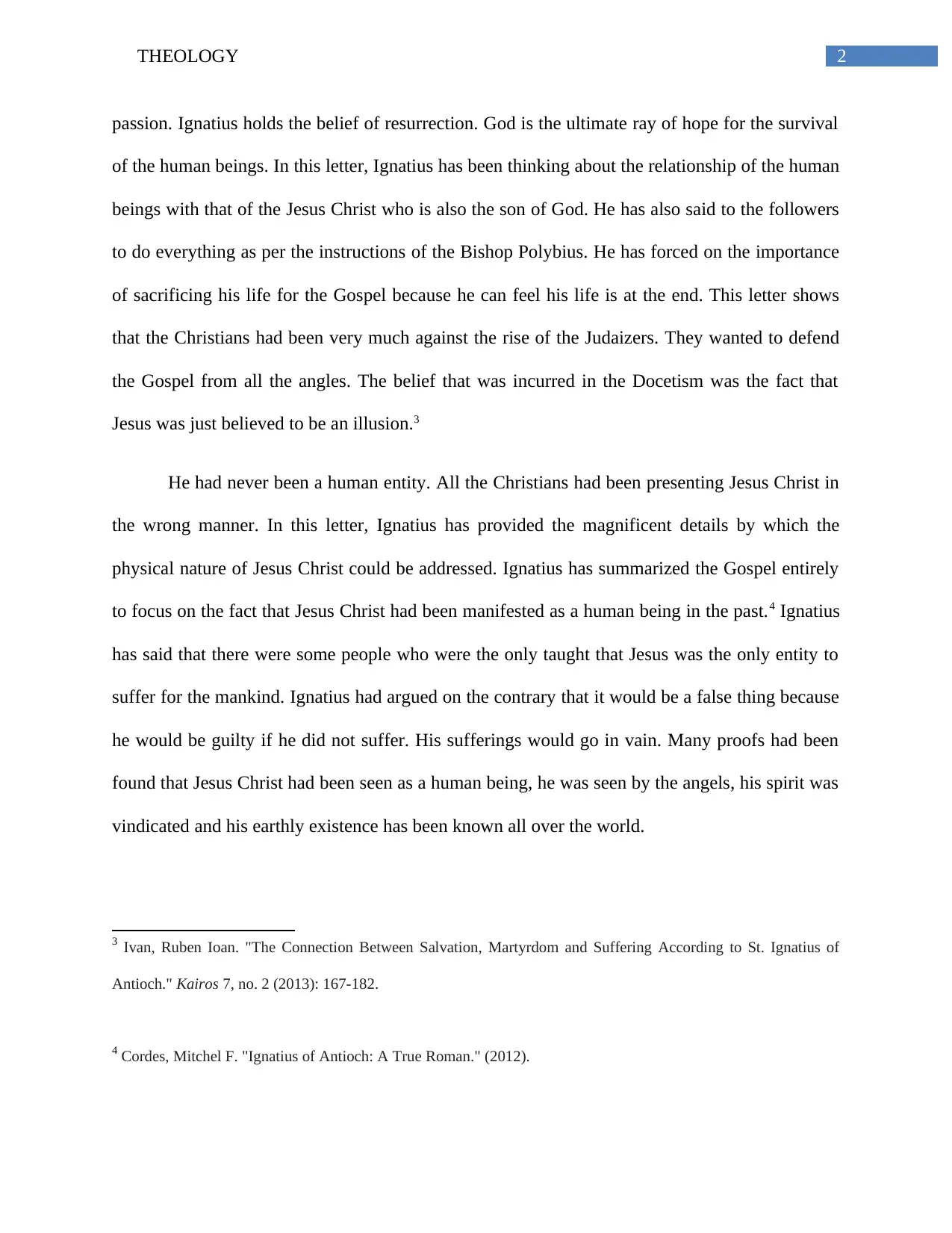
2THEOLOGY
passion. Ignatius holds the belief of resurrection. God is the ultimate ray of hope for the survival
of the human beings. In this letter, Ignatius has been thinking about the relationship of the human
beings with that of the Jesus Christ who is also the son of God. He has also said to the followers
to do everything as per the instructions of the Bishop Polybius. He has forced on the importance
of sacrificing his life for the Gospel because he can feel his life is at the end. This letter shows
that the Christians had been very much against the rise of the Judaizers. They wanted to defend
the Gospel from all the angles. The belief that was incurred in the Docetism was the fact that
Jesus was just believed to be an illusion.3
He had never been a human entity. All the Christians had been presenting Jesus Christ in
the wrong manner. In this letter, Ignatius has provided the magnificent details by which the
physical nature of Jesus Christ could be addressed. Ignatius has summarized the Gospel entirely
to focus on the fact that Jesus Christ had been manifested as a human being in the past.4 Ignatius
has said that there were some people who were the only taught that Jesus was the only entity to
suffer for the mankind. Ignatius had argued on the contrary that it would be a false thing because
he would be guilty if he did not suffer. His sufferings would go in vain. Many proofs had been
found that Jesus Christ had been seen as a human being, he was seen by the angels, his spirit was
vindicated and his earthly existence has been known all over the world.
3 Ivan, Ruben Ioan. "The Connection Between Salvation, Martyrdom and Suffering According to St. Ignatius of
Antioch." Kairos 7, no. 2 (2013): 167-182.
4 Cordes, Mitchel F. "Ignatius of Antioch: A True Roman." (2012).
passion. Ignatius holds the belief of resurrection. God is the ultimate ray of hope for the survival
of the human beings. In this letter, Ignatius has been thinking about the relationship of the human
beings with that of the Jesus Christ who is also the son of God. He has also said to the followers
to do everything as per the instructions of the Bishop Polybius. He has forced on the importance
of sacrificing his life for the Gospel because he can feel his life is at the end. This letter shows
that the Christians had been very much against the rise of the Judaizers. They wanted to defend
the Gospel from all the angles. The belief that was incurred in the Docetism was the fact that
Jesus was just believed to be an illusion.3
He had never been a human entity. All the Christians had been presenting Jesus Christ in
the wrong manner. In this letter, Ignatius has provided the magnificent details by which the
physical nature of Jesus Christ could be addressed. Ignatius has summarized the Gospel entirely
to focus on the fact that Jesus Christ had been manifested as a human being in the past.4 Ignatius
has said that there were some people who were the only taught that Jesus was the only entity to
suffer for the mankind. Ignatius had argued on the contrary that it would be a false thing because
he would be guilty if he did not suffer. His sufferings would go in vain. Many proofs had been
found that Jesus Christ had been seen as a human being, he was seen by the angels, his spirit was
vindicated and his earthly existence has been known all over the world.
3 Ivan, Ruben Ioan. "The Connection Between Salvation, Martyrdom and Suffering According to St. Ignatius of
Antioch." Kairos 7, no. 2 (2013): 167-182.
4 Cordes, Mitchel F. "Ignatius of Antioch: A True Roman." (2012).
⊘ This is a preview!⊘
Do you want full access?
Subscribe today to unlock all pages.

Trusted by 1+ million students worldwide
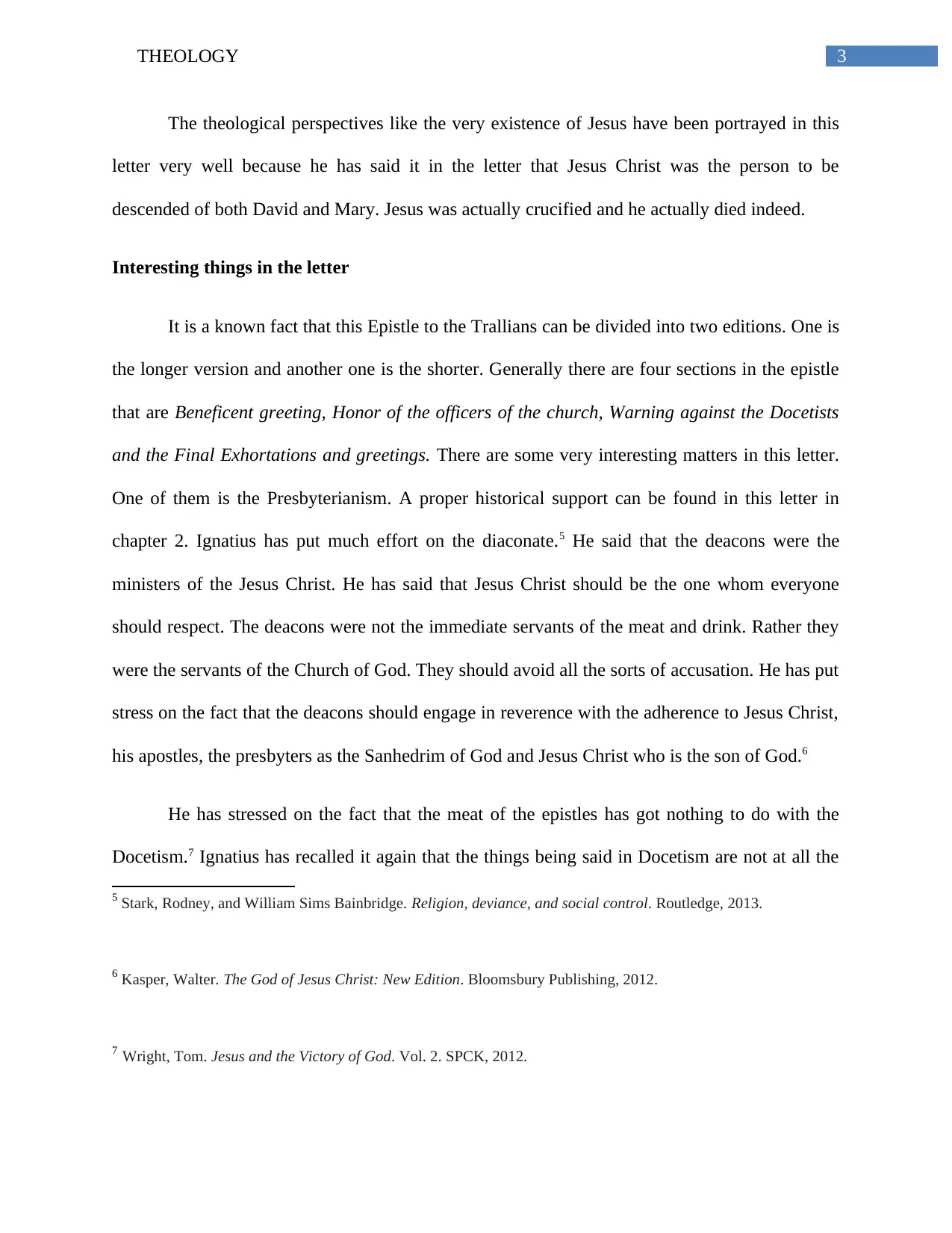
3THEOLOGY
The theological perspectives like the very existence of Jesus have been portrayed in this
letter very well because he has said it in the letter that Jesus Christ was the person to be
descended of both David and Mary. Jesus was actually crucified and he actually died indeed.
Interesting things in the letter
It is a known fact that this Epistle to the Trallians can be divided into two editions. One is
the longer version and another one is the shorter. Generally there are four sections in the epistle
that are Beneficent greeting, Honor of the officers of the church, Warning against the Docetists
and the Final Exhortations and greetings. There are some very interesting matters in this letter.
One of them is the Presbyterianism. A proper historical support can be found in this letter in
chapter 2. Ignatius has put much effort on the diaconate.5 He said that the deacons were the
ministers of the Jesus Christ. He has said that Jesus Christ should be the one whom everyone
should respect. The deacons were not the immediate servants of the meat and drink. Rather they
were the servants of the Church of God. They should avoid all the sorts of accusation. He has put
stress on the fact that the deacons should engage in reverence with the adherence to Jesus Christ,
his apostles, the presbyters as the Sanhedrim of God and Jesus Christ who is the son of God.6
He has stressed on the fact that the meat of the epistles has got nothing to do with the
Docetism.7 Ignatius has recalled it again that the things being said in Docetism are not at all the
5 Stark, Rodney, and William Sims Bainbridge. Religion, deviance, and social control. Routledge, 2013.
6 Kasper, Walter. The God of Jesus Christ: New Edition. Bloomsbury Publishing, 2012.
7 Wright, Tom. Jesus and the Victory of God. Vol. 2. SPCK, 2012.
The theological perspectives like the very existence of Jesus have been portrayed in this
letter very well because he has said it in the letter that Jesus Christ was the person to be
descended of both David and Mary. Jesus was actually crucified and he actually died indeed.
Interesting things in the letter
It is a known fact that this Epistle to the Trallians can be divided into two editions. One is
the longer version and another one is the shorter. Generally there are four sections in the epistle
that are Beneficent greeting, Honor of the officers of the church, Warning against the Docetists
and the Final Exhortations and greetings. There are some very interesting matters in this letter.
One of them is the Presbyterianism. A proper historical support can be found in this letter in
chapter 2. Ignatius has put much effort on the diaconate.5 He said that the deacons were the
ministers of the Jesus Christ. He has said that Jesus Christ should be the one whom everyone
should respect. The deacons were not the immediate servants of the meat and drink. Rather they
were the servants of the Church of God. They should avoid all the sorts of accusation. He has put
stress on the fact that the deacons should engage in reverence with the adherence to Jesus Christ,
his apostles, the presbyters as the Sanhedrim of God and Jesus Christ who is the son of God.6
He has stressed on the fact that the meat of the epistles has got nothing to do with the
Docetism.7 Ignatius has recalled it again that the things being said in Docetism are not at all the
5 Stark, Rodney, and William Sims Bainbridge. Religion, deviance, and social control. Routledge, 2013.
6 Kasper, Walter. The God of Jesus Christ: New Edition. Bloomsbury Publishing, 2012.
7 Wright, Tom. Jesus and the Victory of God. Vol. 2. SPCK, 2012.
Paraphrase This Document
Need a fresh take? Get an instant paraphrase of this document with our AI Paraphraser
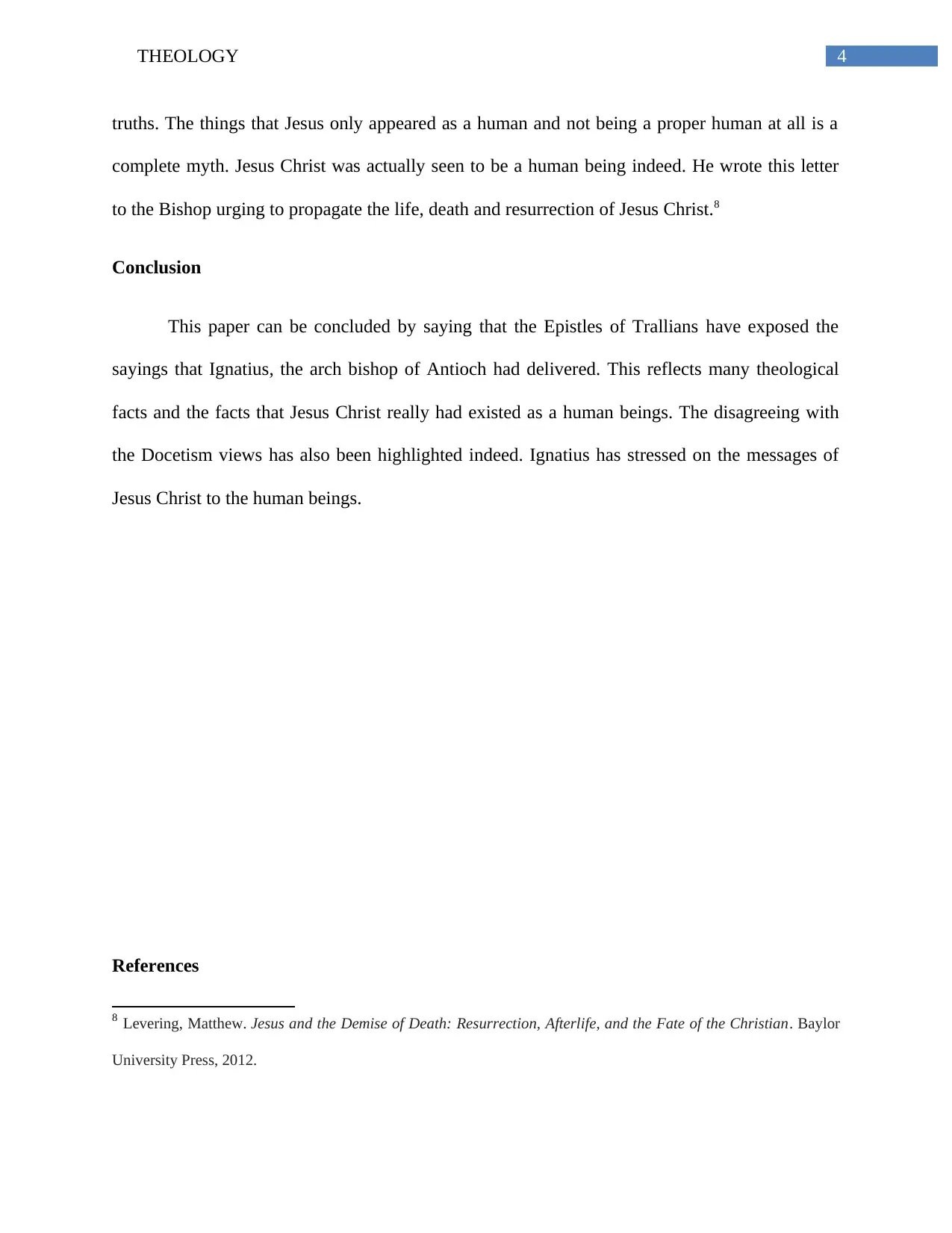
4THEOLOGY
truths. The things that Jesus only appeared as a human and not being a proper human at all is a
complete myth. Jesus Christ was actually seen to be a human being indeed. He wrote this letter
to the Bishop urging to propagate the life, death and resurrection of Jesus Christ.8
Conclusion
This paper can be concluded by saying that the Epistles of Trallians have exposed the
sayings that Ignatius, the arch bishop of Antioch had delivered. This reflects many theological
facts and the facts that Jesus Christ really had existed as a human beings. The disagreeing with
the Docetism views has also been highlighted indeed. Ignatius has stressed on the messages of
Jesus Christ to the human beings.
References
8 Levering, Matthew. Jesus and the Demise of Death: Resurrection, Afterlife, and the Fate of the Christian. Baylor
University Press, 2012.
truths. The things that Jesus only appeared as a human and not being a proper human at all is a
complete myth. Jesus Christ was actually seen to be a human being indeed. He wrote this letter
to the Bishop urging to propagate the life, death and resurrection of Jesus Christ.8
Conclusion
This paper can be concluded by saying that the Epistles of Trallians have exposed the
sayings that Ignatius, the arch bishop of Antioch had delivered. This reflects many theological
facts and the facts that Jesus Christ really had existed as a human beings. The disagreeing with
the Docetism views has also been highlighted indeed. Ignatius has stressed on the messages of
Jesus Christ to the human beings.
References
8 Levering, Matthew. Jesus and the Demise of Death: Resurrection, Afterlife, and the Fate of the Christian. Baylor
University Press, 2012.
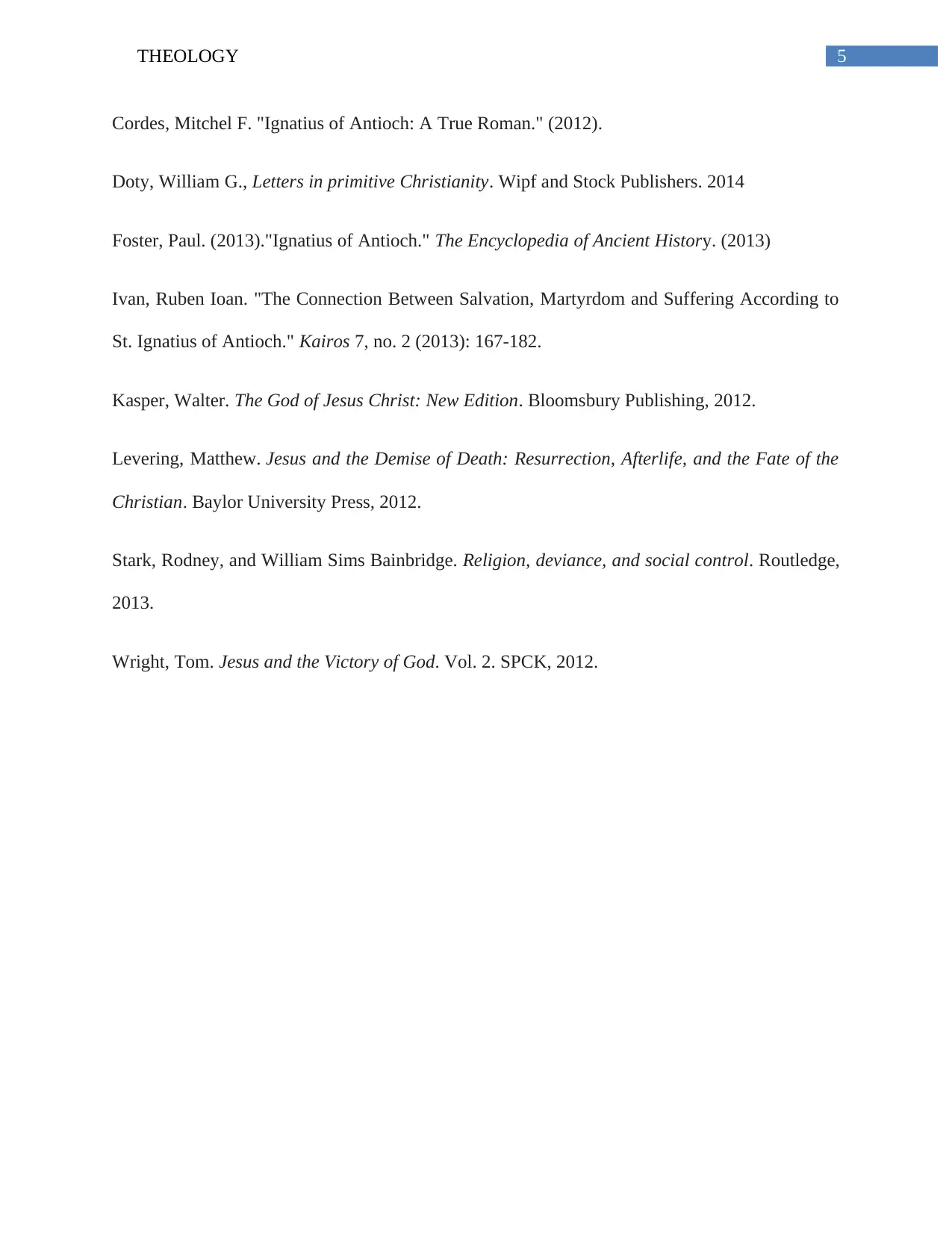
5THEOLOGY
Cordes, Mitchel F. "Ignatius of Antioch: A True Roman." (2012).
Doty, William G., Letters in primitive Christianity. Wipf and Stock Publishers. 2014
Foster, Paul. (2013)."Ignatius of Antioch." The Encyclopedia of Ancient History. (2013)
Ivan, Ruben Ioan. "The Connection Between Salvation, Martyrdom and Suffering According to
St. Ignatius of Antioch." Kairos 7, no. 2 (2013): 167-182.
Kasper, Walter. The God of Jesus Christ: New Edition. Bloomsbury Publishing, 2012.
Levering, Matthew. Jesus and the Demise of Death: Resurrection, Afterlife, and the Fate of the
Christian. Baylor University Press, 2012.
Stark, Rodney, and William Sims Bainbridge. Religion, deviance, and social control. Routledge,
2013.
Wright, Tom. Jesus and the Victory of God. Vol. 2. SPCK, 2012.
Cordes, Mitchel F. "Ignatius of Antioch: A True Roman." (2012).
Doty, William G., Letters in primitive Christianity. Wipf and Stock Publishers. 2014
Foster, Paul. (2013)."Ignatius of Antioch." The Encyclopedia of Ancient History. (2013)
Ivan, Ruben Ioan. "The Connection Between Salvation, Martyrdom and Suffering According to
St. Ignatius of Antioch." Kairos 7, no. 2 (2013): 167-182.
Kasper, Walter. The God of Jesus Christ: New Edition. Bloomsbury Publishing, 2012.
Levering, Matthew. Jesus and the Demise of Death: Resurrection, Afterlife, and the Fate of the
Christian. Baylor University Press, 2012.
Stark, Rodney, and William Sims Bainbridge. Religion, deviance, and social control. Routledge,
2013.
Wright, Tom. Jesus and the Victory of God. Vol. 2. SPCK, 2012.
⊘ This is a preview!⊘
Do you want full access?
Subscribe today to unlock all pages.

Trusted by 1+ million students worldwide
1 out of 6
Related Documents
Your All-in-One AI-Powered Toolkit for Academic Success.
+13062052269
info@desklib.com
Available 24*7 on WhatsApp / Email
![[object Object]](/_next/static/media/star-bottom.7253800d.svg)
Unlock your academic potential
Copyright © 2020–2025 A2Z Services. All Rights Reserved. Developed and managed by ZUCOL.





